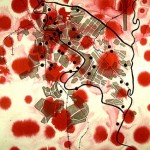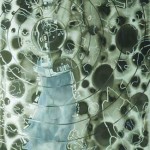By MATTHEW NASH
A few years ago, the Wang Center [1] showed the film Apocalypse Now in its original version. Coppola had run way over budget, and in 1979 Paramount released this unpolished version to a limited audience, probably in the hopes of raising the rest of the necessary money. It contained no titling and almost no musical score.
I will never forget that opening scene depicting the napalming of the tree-line: great plumes of flame emerging from the lush green of the jungle, a slow billowing beauty that hid a great horror. Shown in this unpolished cut, it was deathly silent [2] and I could feel the entire audience holding its breath. Here was a spectacular piece of filmmaking, showing us a stunningly beautiful series of images, requiring us to accept that beauty and horror could exist simultaneously in the same moment, captured in the same frame.
This is how I feel when I look at elin o’Hara slavick’s [3] Bomb After Bomb: A Violent Cartography. This book collects her drawings and shows us the horror in the density and proliferation of United States bombing in the world. Without depicting a single broken body or missing limb, avoiding the shock of burned flesh and crushed bones, her images speak powerfully through the alteration of maps, and create an experience that is both aesthetically pleasing and intellectually horrifying.
Page after page depict a map of a region that has been bombed, stained and marked by o’Hara slavik in ways both violent and beautiful. Some are quite simple, while others are much more dense and dark. One pairing of images (pages 82-3) show this contrast. On the left is an image labeled “Baghdad, Iraq, 1990-Ongoing”; on the right is “Kuwait, 1991”. The Baghdad image is starkly minimal: the black Tigris and Euphrates rivers frame the gray map of the city on a white background. Deep red stains cover the map, appearing as both drops of blood and bomb craters viewed from the air. In contrast, the Kuwait image is nearly obscured by the dense, oily streaks that seem to ooze from beneath the surface of the image.
Many images are marked with symbols that appear to imply some form of cartographic specificity. Circles radiate outward from target icons, arrows point menacingly, and tiny flags flutter as if marking sites of particular interest. Yet there is a decided lack of specificity in most of the images that is both appealing and, sometimes, frustrating.
I am reminded here of Brought To Light, a graphic novel by Alan Moore and Bill Sienkiewicz from 1989. Early in the narrative the character representing the C.I.A. says: “Average body holds a gallon. Big swimming pools hold 20,000 gallons, so imagine a pool filled with blood.” For the remainder of the story, each time an atrocity is described, the margins are filled with tiny illustrations of swimming pools, corresponding to the number of victims.
Now, I don’t want or expect o’Hara slavick to have that kind of specific key to understanding her marks. In fact, there is a lot of impact in having the exact death toll represented by her splatters remain imagined. The human mind (or at least my mind), it seems, can conceive of the extremes without having them declared. Having said that, I sometimes wish that there were a way to correlate her marks to some hard data, if only to confirm my worst fears. [4]
Yet, asking these images to be informative would be like asking those opening moments of Apocalypse Now to be informative, to spell out the number of Vietnamese dying in that jungle. The beauty of that moment, and the message it carries, can only be discovered in the awful self-realization that one has found beauty in murder, and pleasure in horror. At their best, o’Hara slavik’s images do all of this and more.
Bomb After Bomb: A Violent Cartography begins with two great essays that frame the images very well. Howard Zinn discusses the naiveté of bombardiers from his own experiences in World War II, and Carol Mavor considers the aftermath of Hiroshima and Nagasaki in both their beauty and their atrocity. The book concludes with an interview of o’Hara slavick by Catherine Lutz.
Bomb After Bomb requires a lot of your time to consider. The images are full of depth and provoke much self-discovery. The essays are powerful, incendiary, and a perfect pairing with the imagery. Perhaps the best summary of the reasons for this book were penned by Zinn for the forward:
I am stunned by the thought that we, the “civilized” nations, have bombed cities and countrysides and islands for a hundred years. Yet, here in the United States, which is responsible for most of that, the public, as was true of me, does not understand – I mean really understand – what bombs do to people. That failure of imagination, I believe, is critical to explaining why we still have wars, why we accept bombing as a common accompaniment to our foreign policies, without horror or disgust.
- elin o’Hara slavick, World Map, Protesting Cartography: Places The United States Has Bombed, 1854 – Ongoing
- elin o’Hara slavick, Baghdad, Iraq, 1990 – Ongoing
- elin o’Hara slavick, Nagasaki, 1945
----
[1] – Now the CitiCenter
[2] – Later The Doors “The End” would be added to create the version of this scene most people are familiar with
[3] – Please note that this is not a typo. The artist has chosen to use this form of capitalization for her name.
[4] - Update: it should be noted that o'Hara slavick does include a section at the back of the book with in-depth information, including specific numbers, for each image. Although not printed next to each image, this information is available.
Bomb After Bomb: A Violent Cartography can be purchased at Amazon.com
elin o'Hara slavick recently presented her work at a salon on Art and Activism, hosted by Jane D. Marsching and iKatun. This salon resulted in the 45 Questions About Art & Activism published in issue #61.
All images are courtesy of the artist.







